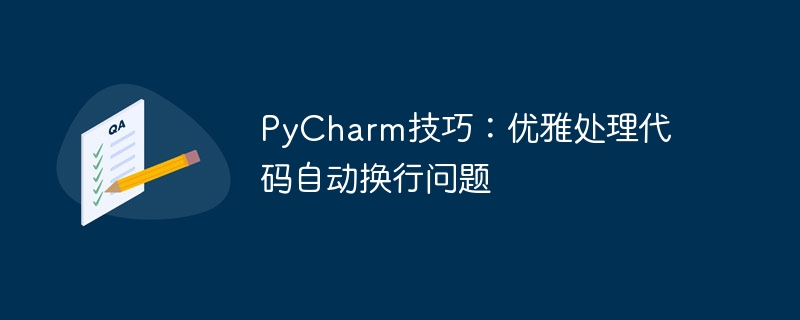

PyCharm Tips: Handle the code automatic line wrapping problem gracefully
In the process of using PyCharm for Python programming, we often encounter the code automatic line wrapping problem, especially when When a line of code is too long, automatic line wrapping may affect the readability and aesthetics of the code. How to deal with this problem gracefully and make the code cleaner and more readable? This article will introduce some techniques for dealing with code automatic line wrapping in PyCharm, and demonstrate it through specific code examples.
In Python, you can use backslash() to indicate the continuity of code, that is, to split a line of code into multiple lines but logically Still one line. In PyCharm, when a line of code is too long, you can automatically wrap it by adding a backslash. Here is an example:
result = 10 + 20 +
30 + 40 +
50
print(result)In this example, a long addition operation is divided into multiple lines, each line ending with a backslash. This not only makes it easier to read, but also keeps the code clean.
In Python, you can use parentheses to wrap a long line of code to achieve automatic line wrapping. In PyCharm, when entering a long expression within parentheses, you can press the Enter key to automatically split the code into multiple lines. An example is as follows:
result = (10 + 20 + 30 +
40 + 50)
print(result)By using brackets, we can split the code into multiple lines more intuitively and improve the readability of the code.
PyCharm also provides a wealth of code style setting options, which can adjust the display method of code according to personal preferences and project needs, including automatic line wrapping. set up. Find the Code Style setting in PyCharm's settings, where you can customize the display style of the code by adjusting parameters, including code indentation, line width, line breaks, etc.
Through the above methods, we can elegantly handle the code automatic line wrapping problem in PyCharm, making the code clearer and easier to read. In the actual programming process, choosing an appropriate way to handle code automatic line wrapping based on personal habits and project needs can improve code writing efficiency and maintainability.
I hope the content introduced in this article will be helpful to everyone! If you have more questions about PyCharm or Python programming, please leave a message to discuss.
The above is the detailed content of PyCharm Tips: Elegantly Handle Code Automatically Wrapping Problems. For more information, please follow other related articles on the PHP Chinese website!
 How to change pycharm to Chinese
How to change pycharm to Chinese
 pycharm installation tutorial
pycharm installation tutorial
 How to set automatic line wrapping in word
How to set automatic line wrapping in word
 How to solve the problem that pycharm cannot find the module
How to solve the problem that pycharm cannot find the module
 How to automatically wrap ireport
How to automatically wrap ireport
 How to install pycharm
How to install pycharm
 The difference between python and pycharm
The difference between python and pycharm
 How to configure the pycharm environment
How to configure the pycharm environment




